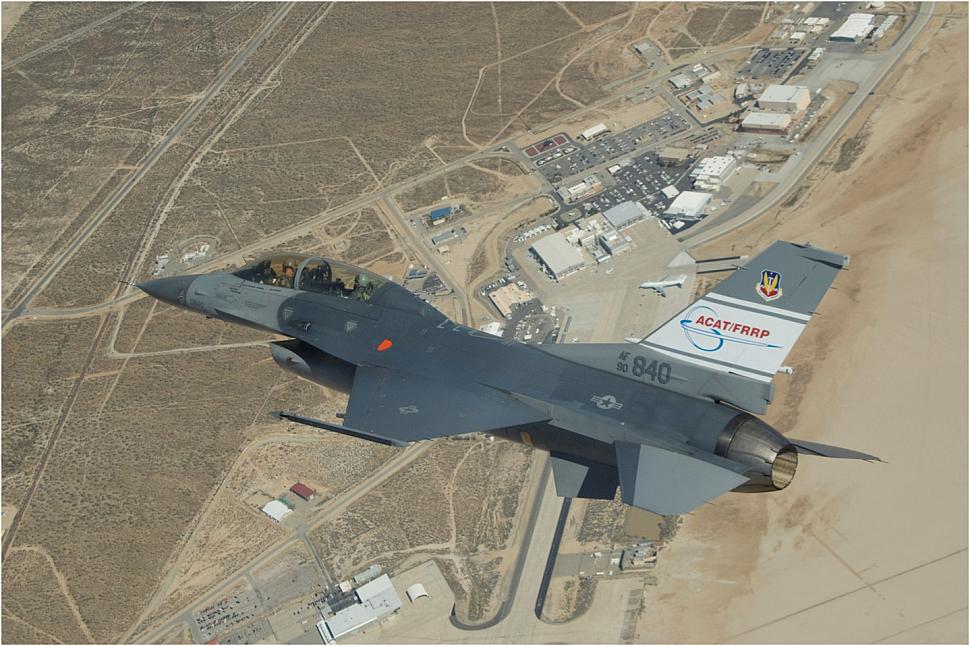Fighter Jet News
F-16 Fighting Falcon News
AFRL concludes Auto-GCAS flight testing
October 4, 2010 (by
Air Force Flight Test Center) -
The 103rd flight signalled the final effort in this phase of testing for the Automatic Ground Collision Avoidance System, part of the Automatic Collision Avoidance Technology/Fighter Risk Reduction Program.
Air Force Research Laboratory researchers, in conjunction with the Air Force Flight Test Center and NASA Dryden have been putting the system through a rigorous schedule for the program that researchers hope will lead to the virtual elimination of fighter aircraft mishaps.
Auto GCAS technology uses information gathered from Global Positioning System data and incorporates it with Digital Terrain Elevation Data maps to enable aircraft to reference terrain below. In the event that an aircraft is flown dangerously close to the ground, this critical data enables the aircraft to automatically execute avoidance manoeuvres without pilot intervention.
Onboard for the final test flight was Lockheed Avionics Design Engineer Charles Canney and NASA project pilot Nils Larsen. The flight took place over a widespread area including portions of California from Edwards Air Force Base to Death Valley and the peaks and canyons of the Sierra Nevada Range. The flight evaluated the ability of the system to fly at low levels without "nuisance fly-ups," or unwarranted activations of the system. Additionally, the system's collision avoidance capability was evaluated with the execution of numerous mishap profiles that are typically seen in the F-16 fleet.
Mr. Canney, who has served as part of the design team for Lockheed since 1989, flew aboard many of the collision avoidance runs throughout this testing effort. He described the final test flight as "the best flight anyone has ever had," and stated, "As Nils got down low, I could see dirt being kicked up off of the desert floor and no nuisance activations."
The Auto GCAS flight testing effort has collected data over the course of over 141 flight hours, with more than 1,600 automatic recoveries executed. The F-16 test aircraft will now be transitioned to the Air Force Flight Test Center 416th Flight Test Squadron, who will begin production flight testing in the next phase of the ACAT program. The Auto GCAS software was recently transitioned to Aeronautical Systems Center, with the goal of incorporating the system into F-16 production aircraft in 2014.
ACAT is a combined effort of AFRL, Lockheed Martin, NASA, and AFFTC. Auto GCAS Flight demonstration participants have included individuals from Office of Secretary of Defense, AFRL, AFFTC, and Air Combat Command.
Auto GCAS technology uses information gathered from Global Positioning System data and incorporates it with Digital Terrain Elevation Data maps to enable aircraft to reference terrain below. In the event that an aircraft is flown dangerously close to the ground, this critical data enables the aircraft to automatically execute avoidance manoeuvres without pilot intervention.
Onboard for the final test flight was Lockheed Avionics Design Engineer Charles Canney and NASA project pilot Nils Larsen. The flight took place over a widespread area including portions of California from Edwards Air Force Base to Death Valley and the peaks and canyons of the Sierra Nevada Range. The flight evaluated the ability of the system to fly at low levels without "nuisance fly-ups," or unwarranted activations of the system. Additionally, the system's collision avoidance capability was evaluated with the execution of numerous mishap profiles that are typically seen in the F-16 fleet.
Mr. Canney, who has served as part of the design team for Lockheed since 1989, flew aboard many of the collision avoidance runs throughout this testing effort. He described the final test flight as "the best flight anyone has ever had," and stated, "As Nils got down low, I could see dirt being kicked up off of the desert floor and no nuisance activations."
The Auto GCAS flight testing effort has collected data over the course of over 141 flight hours, with more than 1,600 automatic recoveries executed. The F-16 test aircraft will now be transitioned to the Air Force Flight Test Center 416th Flight Test Squadron, who will begin production flight testing in the next phase of the ACAT program. The Auto GCAS software was recently transitioned to Aeronautical Systems Center, with the goal of incorporating the system into F-16 production aircraft in 2014.
ACAT is a combined effort of AFRL, Lockheed Martin, NASA, and AFFTC. Auto GCAS Flight demonstration participants have included individuals from Office of Secretary of Defense, AFRL, AFFTC, and Air Combat Command.
Courtesy of Wright-Patterson Air Force Base
Additional images:
Related articles:
Forum discussion:
Tags
- Auto-GCAS approved for block 40 F-16s (2009-10-15)
- Auto-GCAS ready for take-off (2007-08-07)
- F-16 Fighting Falcon news archive
Forum discussion:
- Start a discussion about this article in the F-16.net forum.
Tags


